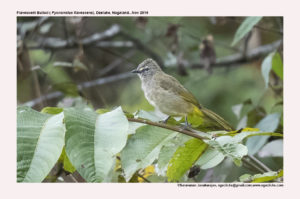
Flavescent Bulbul Pycnonotus flavescens
Etymology :
- Pycnonotus : Greek word puknos thick, compact; notos –backed { thick backed}
- Flavescens: Latin word for Golden- yellow derived from flavescere to become golden
Vernacular Names : Cachar: Dao bulip-gurrmo
Distribution in India: Resident of North East Hills in India.
Description: Size of 21·5–22 cm; wt. of 27·1–35 g. It is a medium-large, drab, bulbul with fairly stout bill, rather long and heavy tail, crown feathers often raised to form odd conical crest. The nominate race has dark brownish grey crown with whitish scaling (in fresh plumage, more uniform dull brown when worn), short white preocular supercilium over dusky-brown loral spot, greyish ear-coverts. The mantle, back, scapulars, rump and uppertail-coverts are dull olive-brown, suffused with stronger greenish or yellowish tint in fresh plumage. The wings are mid-brown, more olive-brown on outer webs, with brighter and yellower fringing on primaries .The tail is dull olive-brown, feathers brighter and yellower at outer fringe, outermost pair with narrow pale tips; chin and throat are pale .The breast is pale yellowish brown, variably streaked darker grey brown, lower belly and undertail-coverts are yellow. The iris is brown to deep reddish brown; bill is black; legs are blackish brown to dark reddish brown. Both the sexes are alike. The juvenile has forehead and crown uniform olivaceous-brown, head generally more yellowish, less prominent supercilium, also more uniform and warmer brown upperparts, slight rusty fringing on wing feathers, brownish throat and breast without streaked appearance, paler yellow vent, and brownish bill.
Habitat: It is found in open forest, edge, second growth, scrub, mossy forest. It is found from 800–2100 m, ranging down to 450 m in winter and sometimes ascending to 3500 m.in breeding time.
Food Habits: It eats berries and invertebrates. It forages at middle levels, but regularly from low bushes to high treetops; rarely or never descends to ground. It is shy and quiet, hidden inside bushes and trees, but may be demonstrative; raises crest feathers when excited.
Breeding habits: They breed in Mar–Jul. The nest is a shallow cup, neatly and firmly made. The nest is made with black fern roots, grass, twigs and tendrils of climbing plants, interwoven with cobwebs, sometimes with leaves, and lined internally with fine grass; placed in fork, or between several upright twigs or stems, in bush or large clump of grass. They lay a clutch of 2–3.The nest is parasitized by Jacobin Cuckoo